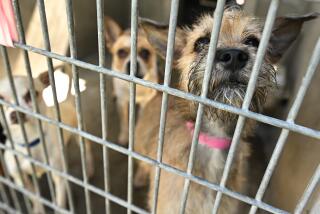Taking on tough dogs in tough neighborhoods
- Share via
Larry Hill is the dean of a small network of dog trainers who are out to save the bully breeds — pit bulls, mastiffs and Rottweilers — of South Los Angeles.
His specialty is tough dogs in tough neighborhoods. In his professional work and monthly free classes, he takes lunging, yelping masses of dog flesh and molds them into gentle companions.
Hill’s mantra is there is nothing wrong with the dogs. It’s the owners who have the problem, as I discovered one Saturday morning at St. Andrews Recreation Center in Gramercy Park.
Dressed in a brown uniform with the name of his nonprofit, Puppy Imprinters, embroidered on the vest, Hill kept his distance, sending us out with our dogs into the field for a walking exercise.
A woman in a purple velour running suit jogged by on the track. Pamela Henderson, an Altadena financial advisor, struggled to get her pit bull Gabriel to heel.
“Who’s the alpha?” Hill asked.
“My other pit Smokey,” said Henderson.
“The other alpha,” he said.
“Oh, me,” Henderson said.
Hill lectured us about our profound ignorance of basic dog behavior, occasionally drowned out by the jets rattling overhead on their way to LAX. We either turn our pets into babies in sweaters and bows, or trick them out in spike collars and bristling harnesses, he said. But we’re clueless about how to get them to do what we want.
We quickly showed him how clueless. “Turn to the right,” Hill called to Henderson. “Don’t stop.”
“I’m sorry. I’m thinking which way is right,” she answered.
I didn’t even get to left or right. Before the first turn, I tripped over my own dog.
Hill loves the bully breeds and gets surprising things from them. His own dog Ryder, a pit bull from fighting stock, stays, comes on command, climbs an obstacle board and speaks in response to hand signals and oral directions.
But Hill knows what goes on in the streets, where dogs are chained, beaten and thrown in the ring. Growing up in Los Angeles, Hill put dogs into fights before he knew any better, he said.
“I started on the other side of the fence, rolling and bumping these dogs,” he told one young man who stopped by to check out the class. “Now I’ve learned to do this.”
His background has given him credibility in these neighborhoods and stripped him of illusions. Hill breaks with many pit bull activists on the question of euthanization. Not every dog can be saved, he believes. Some sick and dangerous dogs inevitably have to be put down, and animal shelters should be frank with the public about this, he says.
That put him at odds with Animal Services, where he worked for 10 years as a clerk at the South L.A. shelter. Hill was quoted in a magazine article accusing Ed Boks, the department chief at the time, of misleading people by calling shelters “no kill.”
Then a supervisor complained Hill had taken home two bags of dog food and the city attorney prosecuted him for petty theft.
Hill said a co-worker told him the food was going to be thrown away because the bags were damaged. Earlier this month, Judge Karen Ackerson-Brazille dismissed the case for lack of evidence. Hill ended up retiring in November with a reduced pension.
That hurt. But Hill’s sentiments are as strong as ever. “Are there some people in society who just can’t conform to the rules?” he said. “Some dogs are like people — incorrigible.”
What really gets him is that Animal Services makes no effort to teach people how to handle their dogs so they won’t end up in the shelters. Training — of people and animals — is the real solution to the city’s bully breed problem, he believes.
“They’ll write you a ticket and get rid of a dog,” he said. “That doesn’t educate people.”
Hill isn’t the first trainer in South L.A. to take that task on himself — he knew TV personality Cesar Millan, the Dog Whisperer, who also started here, “before he could speak English,” he says. Nor are his training techniques completely unique.
What sets Hill apart is that he’s stayed right here, where’s he’s needed, at the epicenter of the pit bull explosion, for more than four decades, learning as he goes. “I’ve thrown out all the stuff that doesn’t work,” he told us.
Hill can be gruff, barking out orders, but he’s also a bit of a clown. That’s just how he wants us to treat our animals. There’s a time to play, and a time to discipline.
He identifies the basic drives that predominate in each dog — prey, socialization, aggression — then tailors his instruction to each animal. The harshest correction is a tug on the leash and sharp command, never physical punishment. The incentives are praise and affection — several strokes down the flanks, followed by a couple of pats.
Hill is not one for false modesty — he credits himself with “an uncanny ability to read dogs.” But that doesn’t seem like an overstatement.
Some of his students had tried obedience classes at mall pet shops and parks, to no avail. Hill shows them that there is more to training than generic treats-and-clickers approaches, and that they can indeed control their dogs.
One of Hill’s regular students was having trouble handling a blue-point pit bull she named Blue Bunny, a name he objected to; in Hill’s world even a dog’s name matters.
Hill told her to take off the training collar and let the dog loose. “I don’t want you to control her. I want her to do what’s inside of her,” he said.
Bunny rolled on his back, leaped in the air and slithered on his belly.
“There isn’t an ounce of aggression in that dog,” Hill laughed.
He is dead serious about his mission, and he expects his students to feel the same.
“Spell dog backwards. Spell dog backwards,” Hill commanded. “That’s right: God. I’m not playing out here.... Everything I say is like the Bible out here.”
Hill wants to do more education work with kids and adult groups. He volunteers with the Downtown Dog Rescue to bring its mobile spay and neuter clinic into Watts. His entire career has been spent between Watts and Gramercy Park, and here he plans to stay.
“Out here in the community, the majority of people can’t afford training,” he said. “Somebody had to be here.”
More to Read
Sign up for Essential California
The most important California stories and recommendations in your inbox every morning.
You may occasionally receive promotional content from the Los Angeles Times.










